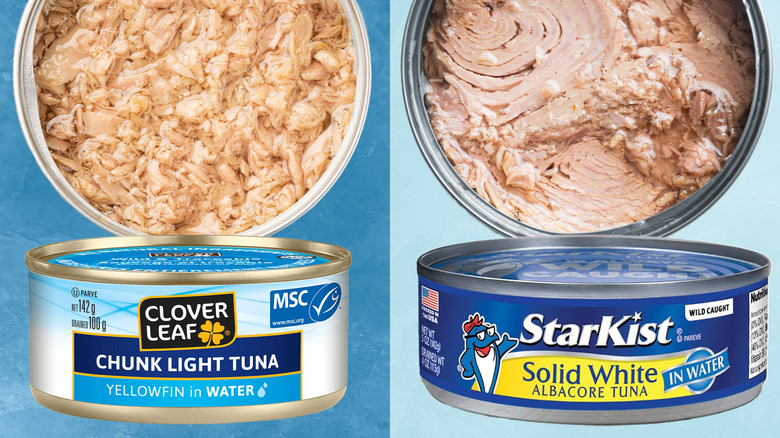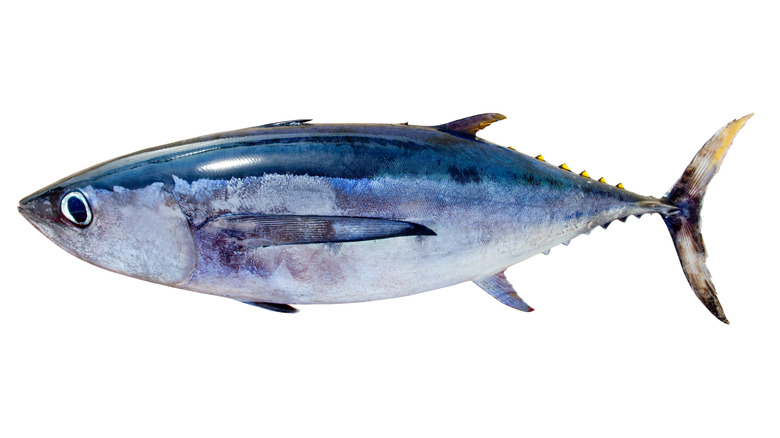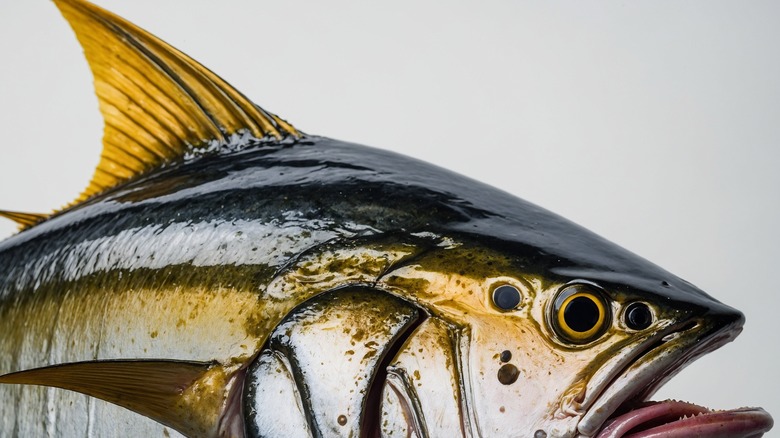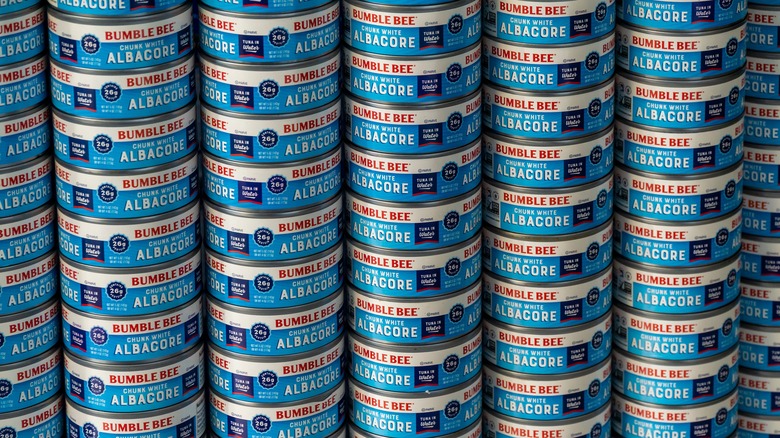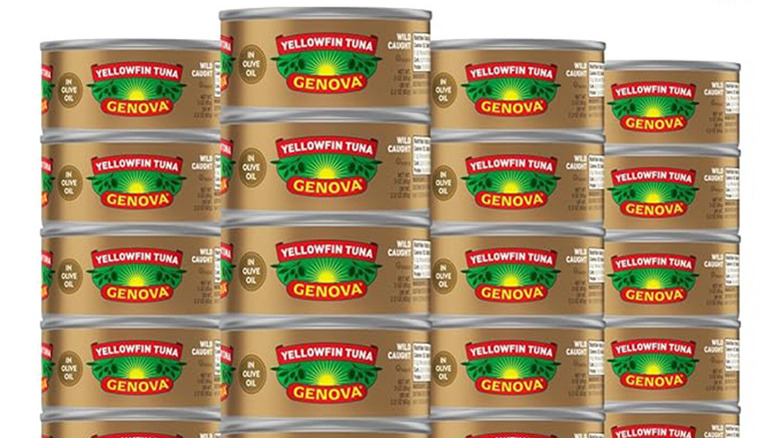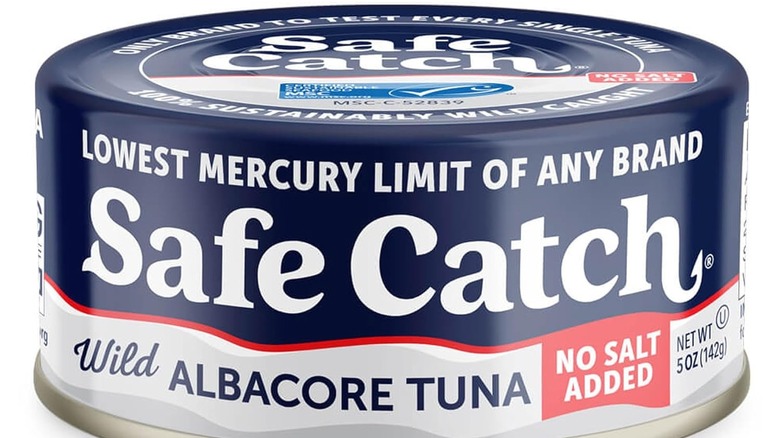Yellowfin Vs Albacore Canned Tuna: What's The Difference?
We may receive a commission on purchases made from links.
Whether you love it, hate it, or feel somewhere in between, canned tuna is a major player in the arena of lunchtime sandwiches and deli-style side dishes. Mixed with some mayo, Dijon mustard, lemon juice, crunchy celery, chives, herbs, and other toss-ins per preference, ordinary canned tuna easily morphs into a simple yet refined tuna sandwich for everyday eating. That's especially true when selecting a specific type for your personal preferences.
Most canned tuna comes in similar packaging, but it's far from being a generic fish. Fifteen known species of tuna exist, seven of them falling into the category of "major species" recognizable to most seafood lovers. Only three commonly make their way into "canned" tuna products, which increasingly include not only cans but pouches and occasionally glass jars. Those three include skipjack and yellowfin, often canned together and sold as chunk light tuna, and the separate "white" albacore tuna, which is considered the most desirable. However, yellowfin presents more often now in its own cans, designated as "gourmet", "tonno," "select," or "premium" tuna.
Flavor and texture are the most noticeable differences in the two top-dog tuna fishes, albacore and yellowfin. But they also have some things in common, including nutritional elements and similar mercury content — a major tuna consumption concern carrying advisories, recommendations, or regulations by government agencies such as the FDA and EPA. Here's a look at how all these things collectively define the fishy forces at play inside your tuna salads, wraps, tacos, and sandwiches.
What is albacore tuna?
Albacore tuna, scientifically known as Thunnus alalunga, is a migratory tuna species thriving in temperate, tropical waters that include the Pacific, Atlantic, and Indian Oceans. It is a well-loved fish, particularly in "white" canned tuna fish offerings. In 2022, Atlantic commercial fisheries hauled in a valued $36 million of the metallic blue and silvery white tunas, which weigh up to 80 pounds. They can travel up to 50 miles per hour, covering extraordinarily long distances, crisscrossing multiple countries and thousands of miles.
In the United States, the Pacific tuna variety is caught in the wild and heavily fished in the waters of Oregon and Washington state, as well as in California, and for primarily local consumption in American Samoa and Hawaii. Its geographic counterpart, the North Atlantic tuna, carries very similar traits in terms of size, coloration, and swim speed. However, only about 1 percent of this northern albacore species gets fished within the United States, mostly in the Mid-Atlantic Southeast, and New England regions. The wide international reach of the Atlantic Ocean supports tuna habitats from as far away as South Africa, Argentina, and Ireland, among others.
It's no wonder that albacore tuna lands in many a can, or "tin" as it's known in some circles. It's considered the upper echelon of readily accessible, shelf-stable fish products, which mostly comes down to the taste.
What is yellowfin tuna?
If you've enjoyed fresh ahi tuna, you may be surprised to learn it also goes by another name. Yellowfin tuna, or Thunnus albacares, is the same fish as ahi, which is its name in the Hawaiian language. Like albacore, the yellowfin has both Pacific and Atlantic versions. It's pretty much available year-round, with Pacific yellowfin caught predominantly in Hawaii, California, and U.S. island territories. The Atlantic version inhabits the U.S. waters of the Gulf of Mexico, as well as the waterways collectively comprising the Mid-Atlantic, New England, and Southeast regions.
Given the ocean environments in which they thrive, almost all yellowfin tunas are caught in the wild, and they meet U.S. regulations for sustainability and responsibly harvested seafood. The same goes for albacore, meaning that both types of canned tuna fit the NOAA description of smart seafood choices.
Yellowfins live roughly seven years, and they're enormous fishes, reaching weights of up to 400 pounds. That's considerably larger than albacores, which weigh around 80 pounds. Many of these characteristics affect the final flavor and texture, as does how the fish are packaged — particularly whether the tuna is canned in water or oil, and the specific type of oil that's used.
Canned albacore tastes milder than yellowfin
When talking flavor, albacore and yellowfin tunas have their own sets of devotees. As a "white meat" tuna, canned albacore carries a mild, light, and clean taste, tinged with a slight natural salinity. People generally consider it more subtle and less "fishy" tasting than other canned tunas, especially the skipjack species generally used in chunk light tuna cans.
Canned yellowfin, on the other hand, is immediately distinguishable from its white albacore counterpart by the tan-to-pink flesh. But more importantly, the flavor stands out for its richer, meatier tones with a hint of sweetness.
With both albacore and yellowfin, the flavor is impacted by how it's packed in the tin, whether using water or oil. Water-packed variants have the most natural tuna taste, which leaves them open to personal interpretation by adding your own customized blend of seasonings, oils, and herbs. Oil packing definitely impacts the flavor of either type of tuna, so take some time to peruse the ingredient list. Olive oil is the ultimate oil for enhancing the taste of albacore or yellowfin, and it's generally available for both canned species. This type of oil adds rich flavor depth to tuna salads and helps keep the mixture moist and pliable.
Textural differences in canned albacore and yellowfin tuna can be subtle
Texturally speaking, the differences between canned albacore and yellowfin may be subtle, but they do exist. Some of it comes down to designations such as solid or chunk tuna, which can describe many types of canned tunas — so check the wording on the tins. For example, Bumblebee describes its solid white albacore as "firm and steaky," suitable for eating straight from the can, while chunk white and chunk light albacore gets separated into smaller pieces before canning, That makes the texture suitable for mixing into pasta dishes, fish tacos, and for making the best tuna salad.
Yellowfin tunas naturally have more tender flesh than albacore, though today's gourmet-stye canned yellowfins are commonly packed in solid fillet form, similar to albacores. They also tend to come packed in olive oils for velvety texture, sometimes even specifying top-shelf cold-pressed extra virgin olive oil. You'll often find yellowfin tunas packed with added ingredients such as crushed red peppers, balsamic vinegar, herbs, and others.
Albacore and yellowfin have similar nutrition and mercury content
At first glance, nutrition values in albacore and yellowfin tuna seem almost identical. But a closer look shows a slightly higher amount of an essential nutrient for heart and brain health. That would be the albacore, and the nutrient is omega-3 fatty acids. It also harbors a bit more fat and calories than yellowfin, but both species offer lean dietary protein and excellent health benefits from not only 0mega-3 but vitamins B and D, and selenium, as well as other valuable minerals.
Then there's the mercury content in tuna, which is particularly concerning for developing fetuses, infants, and young children. It comes from myriad sources, including exposure to things like power plant pollution, manufacturing, and geographical hazards such as volcano eruptions. Albacore and yellowfin contain similar amounts of mercury, which tend to be higher than in some other fish species. That includes other tuna varieties such as skipjack, which can contain as much as three times less mercury. That's mostly due to size, with larger species harboring more mercury than smaller ones. They live longer and feed on smaller fish, which in turn have mercury buildup in their own systems.
That said, the FDA provides a handy chart identifying the best and worst fishes to consume based on potential mercury levels. Albacore and yellowfin tunas both land in the second-most desirable category of "Good Choices." You can also seek out brands such as Safe Catch with specified testing and strict mercury limits.
